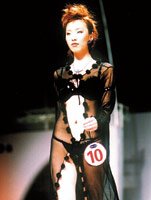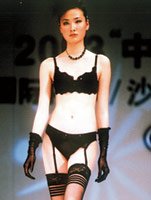International Designers Compete for Coveted China Cup
SHANGHAI, China—Fashion judges jetted in from all over the world—from London, Paris, New York and Los Angeles— to determine whom the winners would be in the China Cup, an annual competition for young international designers and students. The contest was held March 19–22 at the Super Brand Mall, a nine-story shopping center that recently opened in the upscale Pudong district of Shanghai.
The annual event, whose theme this year was titled “In the Name of Peace,” began nine years ago when Shanghai’s mayor decided that a design competition should be held in conjunction with the three-week International Fashion Festival. The mayor wanted to see his burgeoning city placed on the world’s fashion map. He also wanted to wrest the title of “style center” away from Hong Kong.
The woman he placed in charge of this mission was Xu Xiu Qing, a one-time fashion designer who won China’s coveted Tian Qin Award for womenswear design in 1983, when Chinese fashion was an entirely different species. For the past 18 years, Xu has headed the Shanghai Garment Trade Association, a government-backed trade group with 1,000 members.
Under Xu’s direction, the China Cup has grown. The first year, there were 1,000 participants from around the world. This year, there were 2,700 participants, two-thirds of whom were from China.
The contestants entered their designs into four categories— womenswear, menswear, childrenswear and intimate apparel/ swimwear—and an international panel of judges selected 120 finalists whose designs were then presented at fashion shows.
A petite woman with a booming voice that makes up for her size, Xu is a study in motion. Wearing ankle-length black skirts, black boots and zip-front jackets, she spent most of her days during this year’s China Cup shouting into her diminutive cell phone and ordering people around. Cell-phone calls bombarded her with the frequency of raindrops during a downpour.
“The more foreign judges, the more fair the competition,” Xu said, referring to the fact that most of the judges for this year’s event came from overseas. “Last year, the French won the competition for womenswear and menswear. Some people said the reason the Chinese didn’t win was because the judges weren’t from China.”
(The Chinese won the childrenswear and intimate apparel/ swimwear categories last year. This year, the Chinese won first place in every category.)
Xu believes China can only make its mark on the fashion world by having international judges raise the quality of its fashion design.
“Ten years ago there was only a bit of fashion in China,” she noted. “But that is changing. Shanghai is an open city, and many policies are supporting that.”
That support comes from the government, which is keen on taking China beyond its apparel-factory- to-the-world status. It wants to make China a fashion-design center.
That was seen at the intimate apparel/swimwear competition held March 19 inside the cavernous ninth floor of the Super Brand Mall. Under rows of shiny spotlights mounted on a steel track overhead, lithe models strutted down the runway to booming music in front of a panel of judges, which included Ilse Metchek, executive director of the California Fashion Association in Los Angeles.
The winner of the intimate apparel/swimwear competition was Zeng Fengfei, the 35-year-old chief designer of Xia Men in Fujian, China. Zeng’s line of black lace panties, bras and slips had a professional quality that many of the younger students’ designs lacked. Zeng is also launching a menswear line that he plans to showcase at a Beijing fashion show at the end of March.
There were two second-place winners. French designer Camille de la Fouchardiere won for her collection of lightpink underwear. Du Juao, a Shanghai student, won over judges with black-and-white checks and stripes that lent a racing-car effect to the swimwear collection.
The only entry from the United States came from a Chinese student named Zhao Ming who is attending the Fashion Institute of Technology in New York.
While many in Shanghai hope to take the fashion world by storm, most of the judges said the city and the country still have a considerable way to go.
“There was not one junior look on the runway,” said Metchek, who a day earlier had given a speech to Chinese students about California swimwear trends. In her speech, she said there is a new wave of juniors and contemporar y collections in the United States and retail buyers are looking for newness of pattern and trimming.
That newness has not arrived yet in China.
“China in many ways reminds me of where Japan was in the 1970s,” Metchek said.
But things are getting better. Many of the judges who had participated in the China Cup before saw an improvement over previous years.
“The quality of the students is very competitive with many of the Western design schools—but not all of the design schools,” said Margaret Hayes, president of Fashion Group International in New York.
“China has been looking inward for a long time,” said Roger Tredre, editor-inchief of the apparel-industry Web site WGSN.com in London. “But the Chinese market is now becoming more sophisticated.”
























